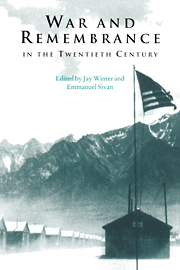Book contents
- Frontmatter
- Contents
- Preface
- Introduction
- 1 Setting the framework
- 2 Forms of kinship and remembrance in the aftermath of the Great War
- 3 War, death, and remembrance in Soviet Russia
- 4 Agents of memory: Spanish Civil War veterans and disabled soldiers
- 5 Children as war victims in postwar European cinema
- 6 From survivor to witness: voices from the Shoah
- 7 Landscapes of loss and remembrance: the case of Little Tokyo in Los Angeles
- 8 The Algerian War in French collective memory
- 9 Private pain and public remembrance in Israel
- 10 Personal narratives and commemoration
- 11 Against consolation: Walter Benjamin and the refusal to mourn
- Index
- Studies in the Social and Cultural History of Modern Warfare
5 - Children as war victims in postwar European cinema
Published online by Cambridge University Press: 27 October 2009
- Frontmatter
- Contents
- Preface
- Introduction
- 1 Setting the framework
- 2 Forms of kinship and remembrance in the aftermath of the Great War
- 3 War, death, and remembrance in Soviet Russia
- 4 Agents of memory: Spanish Civil War veterans and disabled soldiers
- 5 Children as war victims in postwar European cinema
- 6 From survivor to witness: voices from the Shoah
- 7 Landscapes of loss and remembrance: the case of Little Tokyo in Los Angeles
- 8 The Algerian War in French collective memory
- 9 Private pain and public remembrance in Israel
- 10 Personal narratives and commemoration
- 11 Against consolation: Walter Benjamin and the refusal to mourn
- Index
- Studies in the Social and Cultural History of Modern Warfare
Summary
The victims during the First World War were chiefly but not exclusively men obliged to fight and die for what turned out, very soon after the peace treaty, to have been a bad affair. What people remembered was straightforward and very sad: five years spent on the front line had marked the end of the civilized values for which soldiers, in all countries, had mobilized to defend. In their memoirs, in their poems, novels, drawings, or paintings, the survivors did not indulge in moral or patriotic reflections, they attempted to convey the rebarbative reality of the trenches and to produce stories likely to make everybody understand that they went through an ordeal that was like hell.
Things were not as clear cut in the Second World War, so that the memory of the conflict was much more ambivalent. To begin with, the unprecedented extent of casualties and destruction was seen as typical of a modernization process which was ruthlessly sweeping away the systems and societies of the past. By turning armed forces into machines for slaughter, modern warfare tended to annihilate, even in the societies which had successfully waged it, any sense that the combat had been fought, or should have been fought, for the defence of a community. Not surprisingly, emphasis was put on the killing of harmless people, especially of children – that is to say, of their own future – whom societies should have tried to protect.
- Type
- Chapter
- Information
- War and Remembrance in the Twentieth Century , pp. 104 - 124Publisher: Cambridge University PressPrint publication year: 1999
- 2
- Cited by



